Happy holidays, dear readers! The first Christmas cartoon this month is one of the earlier Happy Harmonies produced by MGM!
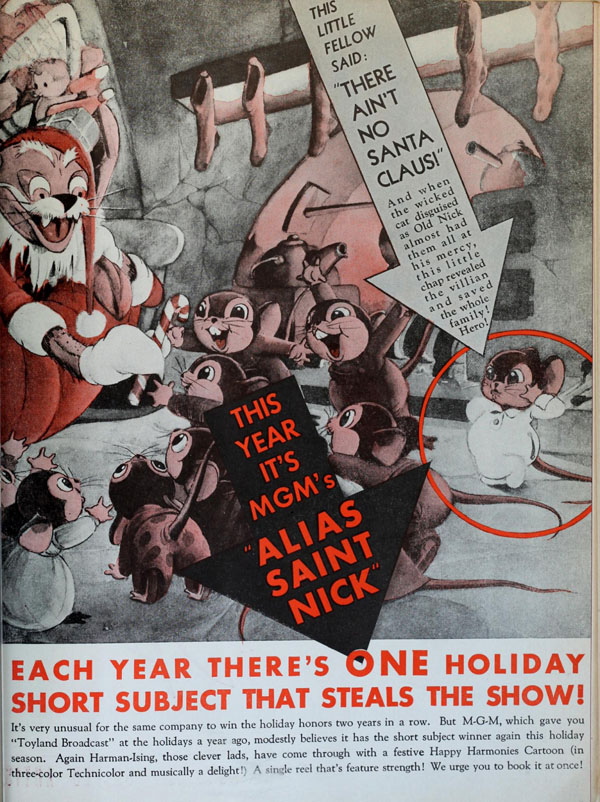
Hugh Harman and Rudy Ising broke their contract with producer Leon Schlesinger early in 1933. They attempted to negotiate with Schlesinger to improve the black-and-white Looney Tunes and Merrie Melodies, but he resisted increasing the budget. From Schlesinger’s perspective, Warner Bros. altered their contract twice to reduce the purchase costs, from $10,000 to $6,000, by March 1933. Harman and Ising delivered their last cartoon in August, and took their Bosko character with them.
 On February 14, 1934, the two signed a contract with MGM — after the studio resolved its involvement with Ub Iwerks — and received agreement for a budget of $12,500 for each cartoon, and to recompense the production costs up to that amount, starting in May. Harman and Ising could finally produce their new Happy Harmonies in color, which they beseeched Schlesinger to adopt earlier. They begun work on a cartoon based on The Nutcracker after their departure, originally planned as a two-reeler — the first of its kind before Max Fleischer’s Popeye — but production ultimately ceased after contractual difficulties.
On February 14, 1934, the two signed a contract with MGM — after the studio resolved its involvement with Ub Iwerks — and received agreement for a budget of $12,500 for each cartoon, and to recompense the production costs up to that amount, starting in May. Harman and Ising could finally produce their new Happy Harmonies in color, which they beseeched Schlesinger to adopt earlier. They begun work on a cartoon based on The Nutcracker after their departure, originally planned as a two-reeler — the first of its kind before Max Fleischer’s Popeye — but production ultimately ceased after contractual difficulties.
The first few Happy Harmonies were processed in two-color Technicolor, and subsequent entries filmed in full three-strip Technicolor, after Disney’s exclusive contract for use of the process expired by September 1935. Ising’s cartoon Alias St. Nick, released November 1935 — premiering in conjunction with the Marx Brothers’ A Night at the Opera — wouldn’t have captured the holiday essence in limited two-color Technicolor.
This cartoon features a tough, skeptical mouse that rebukes the notion of Santa Claus. This character would evolve into Little Cheeser, later a recurring character in the Happy Harmonies. There were not many in the series, besides Bosko and the Louis Armstrong-esque Fog Horn Frog. Alias St. Nick runs about 10 minutes due to its slower timing, more or less based around an overall pattern from the Silly Symphonies. Many animation studios in the thirties used a template in which innocent characters cavort amongst their surroundings until threatened by a menace. The good guys retaliate with their own ingenuity, often fitted to the situation itself. For instance, the toys brought along by the famished cat, dressed as Santa Claus, are used as weapons against him.
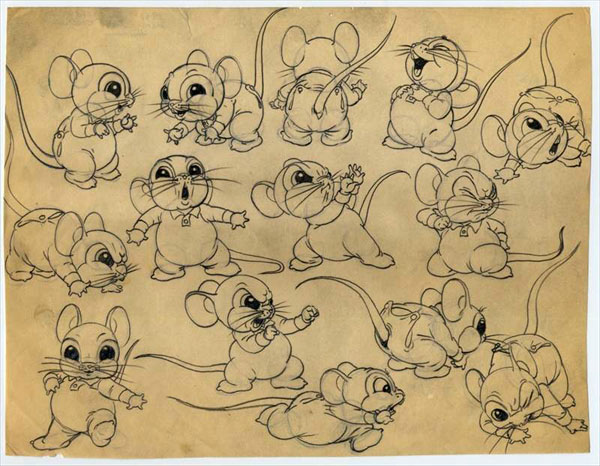
One perplexing footnote in the annals of animation history concerns the Pabian brothers. Both James Anthony Pabian (born April 14, 1909) and Anthony Albert Pabian (born March 3, 1914) referred to themselves as “Tony,” though James often adopted the name “Jim.” According to Rudy Ising, the two brothers often traded their namesake on a regular basis at Harman-Ising. In addition, Alias St. Nick’s draft credits an artist named “Tony” without any indication which brother worked on the cartoon. Based on the surviving evidence of comic book work by Jim Pabian, and stories purportedly drawn by Anthony Pabian, the superior draftsmanship of Jim’s panels clearly matches the drawing in Alias St. Nick; therefore, the proper credit is placed on the breakdown video.
It was fairly common for a Disney short cartoon to have a large amount of artists (1941’s The Little Whirlwind credits 27, including effects animators). In Alias St. Nick’s case, the draft lists 13 character animators. Since the cartoon centers around Christmas, it could be speculated that the occasion led to assigning scenes to a majority — or at least, the entirety — of the character animators Harman-Ising employed during this period. By comparison, other existing Ising drafts credit a lesser quantity of artists. Furthermore, animators Joe D’Igalo and Frank Tipper, are credited with only one shot in the draft.

Rudy Ising and Hugh Harman (hand on shoulder) flank Bill Hanna in this shot of the staff circa 1935. Can you name the other artists in the picture?
Many artists credited on Alias St. Nick were associated with Harman-Ising during their time with Schlesinger. Larry Martin served as a mentor to his young assistant, Bob Clampett, who often drew caricatures of Martin as a villain, with his “hook nose, mustache, toothy grin and dirty laugh.” It later developed into Dishonest John for his animated Beany and Cecil television series. Bob Stokes, an instructor at the Chouinard School of Art, animated at Warners. In 1932, he conducted art classes, and continued to organize lessons at MGM with colleague Lee Blair in the mid-1930s. Mel Shaw (known as Melvin Schwartzman in the ‘30s) worked with Leon Schlesinger as a teenager, during a summer job of designing inter-titles at his Pacific Title and Art Studio. Shaw applied to work for Harman-Ising with tracings of newspaper comic strips when his fine arts portfolio failed to impress. He journeyed to MGM as well, serving as an animator and character designer. Tom McKimson animated for Harman-Ising at Warners, and shifted over with them to MGM while his brother Bob remained at Schlesinger’s.
A few animators joined Warners after Harman and Ising left. Jim Pabian briefly animated at Schlesinger’s following the dissolution of their partnership around 1933, but migrated to MGM a few months later. George Grandpre became the head of the in-betweening pool at Warners and later animated for Bob McKimson in the late ‘50s. Tom McKimson returned to Warners as an animator/character designer for Bob Clampett and Art Davis in the ‘40s. Gil Turner served as an animator, starting in the Hardaway-Dalton unit in the mid-‘30s, and in Friz Freleng’s unit up until the early ‘40s. Frank Tipper animated at Schlesinger’s for a brief period, with credits spanning from 1933-35. Joe D’Igalo became a regular animator for Frank Tashlin’s black-and-white Looney Tunes in the mid-1930s.Some of the credited artists also worked for Disney in the early ‘30s. George Grandpre, Frank Tipper and Joe D’Igalo each served as junior animators in Ben Sharpsteen’s crew. Gil Turner arrived at the studio by January 1933 after his previous occupation as an iceman. Tom McKimson received his start in animation as Norm Ferguson’s assistant before he moved to Romer Grey’s studio in the summer of 1930. Intriguingly, McKimson briefly came back to Disney around 1933, after Harman and Ising left Schlesinger, where he also animated under Sharpsteen. (He is credited on scenes in The Night Before Christmas and The Grasshopper and the Ants.)
Bob Stokes and Mel Shaw flourished at Disney after they left Harman-Ising in the mid-‘30s; Stokes’ specialty in the human figure led to his animation of key sequences of Snow White and the Evil Queen. Shaw became involved with Bambi in its entirety, and also contributed to Fantasia and The Wind in the Willows (later produced as a segment of The Adventures of Ichabod and Mr. Toad). He left during the 1941 strike, but returned to the studio in the early ‘70s, and collaborated on such features as The Fox and the Hound, The Black Cauldron, The Great Mouse Detective, Beauty and the Beast and The Lion King.
Like Pabian, Tom McKimson and Gil Turner turned to comic book work. Both drew stories for Western Publishing’s Dell Comics outfit, specializing mostly on funny animal books. McKimson worked freelance for Dell in 1944, illustrating comics with the Warners characters. He left the studio and officially joined the company as their art director from 1947 to 1972. He also created a daily Roy Rogers strip with his brother Charles, under the pseudonym “Al McKimson.”Turner worked for Benjamin Sangor’s comic shop in the ‘40s, drawing funny animal comics for Better Publications, American Comics Group and Dearfield Comics before moving to Dell. Turner was the writer/artist on the L’il Bad Wolf stories alongside Carl Barks’ Donald Duck in the top-selling monthly, Walt Disney’s Comics and Stories. Like McKimson, his work was not only limited to animated characters — he drew his own newspaper comic strips, Chico (1948-49) and Holly Wood in the early ‘50s.
The draft seen here (from photocopies made in early 1979) is hand-written, but most of the notes are very faint and hard to read. Upon close examination, and a slight tweak in picture contrast, the artist credits are now clarified on the breakdown video. Help yourself to a mug of hot cocoa (perhaps with tiny marshmallows) and enjoy.
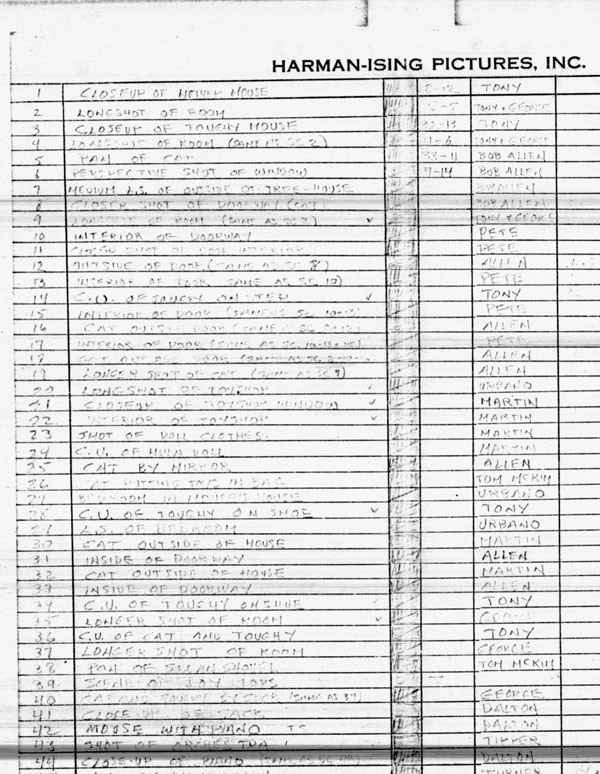

(Thanks to Michael Barrier, J.B. Kaufman, Frank Young, Yowp, Dave Smith and Joakim Gunnarsson for their help.)


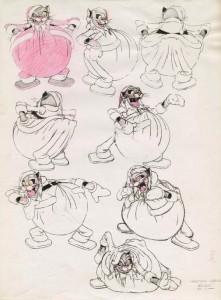
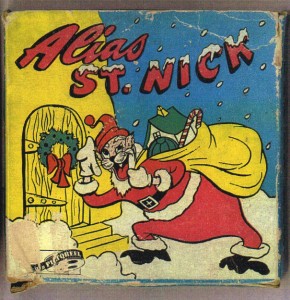
 DEVON BAXTER is a film restoration artist, video editor, and animation researcher/writer currently residing in Pennsylvania. He also hosts a
DEVON BAXTER is a film restoration artist, video editor, and animation researcher/writer currently residing in Pennsylvania. He also hosts a 





















































































This is one of my favorite Christmas cartoons. My grandma had this on video, but it was the home movie version. It was shortened and had several scenes spliced out. I was glad to find the original uncut version on YouTube.
“This cartoon features a tough, skeptical mouse that rebukes the notion of Santa Claus. ”
I think you mean “refutes.”
Actually, I’ve both seen and owned 16mm home movie prints of this that had DIFFERENT scenes edited out! One Pictoreels print removed the scenes of the cat disguising himself in the toy shop, an Official Films print minus the sequence of the mice playing with their toys; and finally a different Pictoreels print that was fully complete (and almost a full 400 foot reel!)
Hollywood Film Enterprises also had a line of Harman-Ising cartoons for several years, though I’m not sure if any of their titles overlapped Pictoreels’ (HFE had the Boskos and others which Pictoreels, as far as I know, never did.) And just to add to the confusion, Pictoreels manufactured a separate home movie line for Sears, Roebuck under the trade name Sero-Crest Films!
Yeah, it really does seem as if the proto-Cheezer is out to squelch belief in St. Nick, even laughing at the notion at the iris out, as if to say to every mouse and child within ear and eye shot “See? I told ya so!” This is a cartoon I saw as a child as part of that favorite toon compilation show called “THE EARLY BIRD CARTOON SHOW” as local programming before the morning newscast, and I remember it and “THE CAPTAIN’S CHRISTMAS” showing up on Christmas morning. Since it is a seasonal cartoon, it really wasn’t in heavy rotation, even though winter cartoons were shown during the summer months and “ONE HAM’S FAMILY” was also shown off-season, but that Avery classic just happened to take place on Christmas morning. Correct me if I’m wrong, but MGM seemed to have the most Christmas cartoons of any of the major studios, and some of the toys here would also show up in “THE PUPS’ CHRISTMAS” which is another wild cartoon that almost turns a family’s Holiday morning into a battlefield. This is a great entry, though, and thanks for yet more background on the Harman/Ising studio.
You mention Bill Hanna in passing with a photograph. I wonder if he had anything to do with this cartoon. He would go on to direct “TO SPRING” and then the TOM AND JERRY series, but was he with Hugh and Rudy, creating some of the HAPPY HARMONIES as well?
Certainly interesting in that regard, the rare holiday film where the skeptic is ultimately the hero by virtue of being the skeptic. Even the trade ads lampshade this.
” it really does seem as if the proto-Cheezer is out to squelch belief in St. Nick”
You mean the kids in the audience’s belief? MGM’s “The Captain’s Christmas” also carries a “there ain’t no Santa Claus” message. I hope that in the world of this cartoon, Santa does exist, as the Mama mouse seemed pretty convinced by the cat’s disguise and is unlikely to have got her kids any presents herself if she expects the real deal to turn up.
It’s also one of those interesting cartoon situations where you wonder why the cat went through all that trouble of of impersonating Santa Claus and burglarizing a toy store when he could have just burglarized the butcher shop instead and made off with a sack full of meat.
Guess he really had particular desire for mouse.
One of my all times favorite Christmas cartoons. So this little “Scrooge” like mouseling was to be Little Cheeser MGM’s first rodent superstar before Jerry Mouse? Love the part when he did a “I told ya so!” to his siblings wearing the fake beard and Santa’s hat after they defeated the scrawny alley cat who was masquerading as St Nick.
Al Pabian worked for the Fleischers in Miami (credited as Tony). I met him in a cafeteria lineup many years ago – at that time he told me he worked on Gulliver and Popeye. His memory was shit and he couldn’t recall exactly what he had animated. He animated for Myron Waldman’s unit, and Myron had nothing good to say about him, stating he was hired on false pretence, passing himself off as his brother, who was a better animator.
The Tony Pabian credited on the Fleischer cartoons was Al Pabian, not Tony or Jim?
Hmm, maybe the comic strip “purportedly drawn by Anthony Pabian” was Al as well…
Somehow I missed this three years ago but I’d like to try to clear up a couple of things. My dad, Al Pabian (1918 – 2015) never worked for Fleischer – that was Anthony “Tony” Pabian – last on Gullliver’s opening credits. The confusion is probably due to the fact that Tony’s middle name was Albert. (I’ll add more confusion here by mentioning that another cousin of my dad’s told me that the Gulliver animator was really Jim, down in Miami trying to boost his brother’s poor reputation, but I didn’t hear this until Jim was gone and couldn’t check on it.) Tony had Alzheimer’s in his later years, but I don’t know about his mental state when his memory was classified as shit. My dad Al Pabian, who was still animating for Melendez with a non-shit memory in his 80s, was originally from NY but worked only in California, having been brought to Hollywood barely out of his teens by his cousin Jim, who had seen his drawings and paintings while visiting the old Rochester neighborhood. Finally, apropos of nothing except that his name also appears on this page, my mom’s brother was Frank Tipper, making for quite a rarefied atmosphere for my brother and me to grow up in. After a cocktail or six, Uncle Frankie would unloose the animation closet skeletons for our amazement and delight. As long as our parents were nowhere in sight.
Sorry – my mistake. Previous to making the comment I was researching the credits of the various Pabians on Imdb. I mistakenly wrote Al instead of Anthony. I should have known better – the friend who introduced us had worked at Filmation, the same place where Anthony had been working.
Fantastic cartoon, thanks Devon!
Interesting animator casting – sometimes they are cast by location (i.e., Pete Burness animates the scenes at the top of the stairs at the front door). “Tony” Pabian mostly gets close-ups of the lead mouse, identified in the draft as “Toughy”.
btw, “The Little Whirlwind” credits “only” 17 animators, not 27.
Strike that last sentence. There are indeed 27 names on the draft. 10 character animators and a whopping 17 effect artists!
I think the man to the left of Rudolf Ising in the photo is Max Maxwell.
Looking at the list of animators again, it’s strange to see them all on the same cartoon, particularly Frank Tipper and Cal Dalton (they must have worked on “Alias St Nick” in a brief period after Tipper left Warners and before Dalton arrived there). Also, I believe it was generally accepted that Bob Stokes didn’t work on any of the Happy Harmonies, severing his ties with Harman and Ising after they stopped making cartoons for Warners and instead going to work for Ub Iwerks before jumping ship to Disney.
I’m glad I followed the link to your cartoon research page and the discussion about this cartoon Alias st. Nick I will be showing my 16 mm Kodachrome print of it on Saturday night to a small group of friends and I will come prepared with a lot of information to share about this amazing first cartoon in the series thank you again for making cartoon research available to the rest of us cartoon fans!
Dan Aument in West Michigan